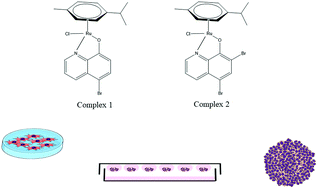Comparative antitumor studies of organoruthenium complexes with 8-hydroxyquinolines on 2D and 3D cell models of bone, lung and breast cancer†
Abstract
The purpose of this work was to screen the antitumor actions of two metal organoruthenium-8-hydroxyquinolinato (Ru-hq) complexes to find a potential novel agent for bone, lung and breast chemotherapies. We showed that ruthenium compounds (1 and 2) impaired the cell viability of human bone (MG-63), lung (A549) and breast (MCF7) cancer cells with greater selectivity and specificity than cisplatin. Besides, complexes 1 and 2 decreased proliferation, migration and invasion on cell monolayers at lower concentrations (2.5–10 μM). In addition, both compounds induced genotoxicity revealed by the micronucleus test, which led to G2/M cell cycle arrest and induced the tumor cells to undergo apoptosis. On the other hand, in multicellular 3D models (multicellular spheroids; MCS), 1 and 2 overcame CDDP presenting lower IC50 values only in MCS of lung origin. Moreover, 1 outperformed 2 in MCS of bone and breast origin. Finally, our findings revealed that both compounds inhibited the cell invasion of multicellular spheroids, showing that complex 1 exhibited the most important antimetastatic action. Taken together, these results indicate that compound 1 is an interesting candidate to be tested on in vivo models as a novel strategy for anticancer therapy.



 Please wait while we load your content...
Please wait while we load your content...